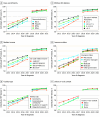Trends in Human Papillomavirus Testing Among Patients With Oropharyngeal Cancer
- PMID: 40728789
- PMCID: PMC12308448
- DOI: 10.1001/jamanetworkopen.2025.23917
Trends in Human Papillomavirus Testing Among Patients With Oropharyngeal Cancer
Abstract
Importance: Due to the prognostic value of human papillomavirus (HPV) status, HPV testing for oropharyngeal squamous cell carcinoma (OPSCC) has been recommended since 2012. However, recent HPV testing rates and associated sociodemographic and clinical factors are unknown.
Objective: To examine HPV testing rates stratified by sociodemographic and clinical factors and factors associated with increased likelihood of not receiving HPV testing from 2013 to 2021.
Design, setting, and participants: In this hospital-based cross-sectional study, the National Cancer Database (NCDB) was queried in 2024 for any patient diagnosed with OPSCC from 2013 to 2021, creating a retrospective cohort of 135 756 individuals. Two subsets were formed based on year of diagnosis: 2013-2017 and 2018-2021.
Exposures: Sociodemographic characteristics (ie, age, race and ethnicity, sex, insurance status, zip code median income, and zip code educational attainment) and clinical factors (ie, year of diagnosis, subsite, overall stage, and facility type).
Main outcomes and measures: The outcome variable was HPV testing status (tested vs not tested). Differences in HPV testing were assessed using χ2 and Mann-Whitney U testing. Trends in HPV testing were examined with annual percentage change longitudinally from 2013 to 2021. Factors associated with the increased probability of not receiving HPV testing were identified using Poisson regression.
Results: The total population was 135 756 patients with OPSCC (7.3% Black, 3.9% Hispanic, 86.2% White, 2.6% other; 83.4% male). From 2013 to 2017, a total of 70 911 patients were diagnosed with OPSCC (82.9% male and 17.1% female). Of these, 50 494 (71.2%) were tested for HPV (median [IQR] age, 60 [47-73] years), whereas 20 417 (28.8%) were not tested for HPV or had unknown testing status (median [IQR], 62 [48-76] years). From 2018 to 2021, a total of 64 845 patients were diagnosed with OPSCC (83.9% male and 16.1% female). Of these, 60 184 (92.8%) were tested for HPV (median [IQR] age, 63 [50-76] years), whereas 4661 (7.2%) were not tested for HPV or had unknown testing status (median [IQR], 64 [49-79] years). In a multivariable analysis, patients with OPSCC who were diagnosed from 2018 to 2021 at community (prevalence ratio [PR], 1.36; 95% CI, 1.20-1.54), comprehensive community (PR, 1.20; 95% CI, 1.11-1.29), or integrated network (PR, 1.17; 95% CI, 1.06-1.28) cancer programs were more likely not to be tested for HPV compared with academic or research programs. Patients with OPSCC diagnosed from 2018 to 2021 of Black (PR, 1.18; 95% CI, 1.05-1.33) or other race (PR, 1.39; 95% CI, 1.17-1.66) were more likely not to be tested compared with White patients.
Conclusions and relevance: This cross-sectional study found substandard HPV testing rates and HPV testing disparities for patients with OPSCC in the NCDB from 2013 to 2021. These findings underscore the need for increased scrutiny of HPV testing practices, particularly at community cancer programs and among patients of races other than White, to ensure that OPSCC guidelines are met.
Conflict of interest statement
Figures
References
MeSH terms
LinkOut - more resources
Full Text Sources
Research Materials
Miscellaneous


